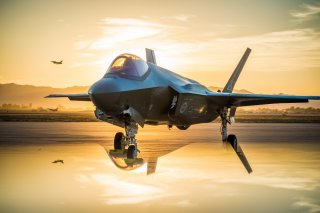China Expresses Confidence in It’s Sixth-Generation Stealth Fighter
It is not clear how far along such an effort may be, at least in terms of what the report cites, however the article in the Chinese-government backed Global Times makes the statement that the U.S. next-generation fighter (sixth-generation) may “trail” China’s.
Here's What You Need to Remember: There is reason for this to be a source of concern for America, as it takes little imagination to simply “observe” that, at least in terms of external stealth configurations, the Chinese J-20 and J-31 aircraft reveal a “probably not just coincidental” resemblance to the U.S. F-22 and F-35 stealth fighters. If the Chinese are set on trying to steal and copy the stealth design configurations of a U.S. sixth-generation warplane, it would likely encourage the United States to keep its plane hidden for quite some time to maintain America’s advantage.
Chinese news reports claim the People’s Liberation Army-Air Force is developing a “next-generation” aircraft for 2035, something which seems clearly intended to rival or outmatch the now already flown U.S. sixth-generation stealth fighter aircraft.
It is not clear how far along such an effort may be, at least in terms of what the report cites, however the article in the Chinese-government backed Global Times makes the statement that the U.S. next-generation fighter (sixth-generation) may “trail” China’s. It does not seem clear how this could be possible, given that the U.S. prototype has already taken to the skies. The claims made in the Global Times raises questions as to whether China is secretly flying its own sixth-generation jet or if Beijing is simply posturing?
Beside, plans to bring the aircraft into existence by 2035, if accurate, would put the Chinese well behind the United States, given the extent to which early subsystem prototyping, conceptual work and digital engineering have yielded massively accelerated results in the U.S. sixth-generation jet fighter program.
The plane’s maker Shenyang Aircraft is a subsidiary of the state-owned Aviation Industry Corporation of China, and the Global Times reports that the Shenyang Aircraft is announcing that it is conducting research on “thermal adaptation and integration of structure and function.”
Thermal signature reduction and an aerodynamically-oriented integration of “structure and function,” as cited by the Chinese report, clearly raise concepts and areas of focus fundamental to stealth design. Of course, managing the heat signature of an aircraft is a well-known focus within the sphere of stealth engineering as heat-sensitive infrared sensors can locate emissions coming from an aircraft’s engines or exhaust. “Structure and function” concepts also invoke thinking along stealthy lines, as a blended wing-body configurations, horizontal shapes and the absence of protruding external structures are all indispensable elements of stealth engineering.
Part of the art and scientific innovation needed to bring stealth to life involves measured assessments of how variants configurations will impact operational functionality. Will removing weapons pylons and relying purely upon an internal weapons bay bring highly valuable new levels of stealth? If yes, how must that be weighed against the importance of needing to carry a heavier payload or fire a larger number of air-to-air missiles? Certainly, there are tradeoffs, yet the Chinese are known to be capable of engineering stealth fighter jets, as evidenced by the external structure of its J-20 and J-31 warplanes.
What much of this brings to mind is the fact that the U.S. sixth-generation demonstrator aircraft, which has already flown, has not been seen. Perhaps this is exactly what is intended, as an ability to simply view its external structures might offer insights into new generations of stealth technology. There is reason for this to be a source of concern for America, as it takes little imagination to simply “observe” that, at least in terms of external stealth configurations, the Chinese J-20 and J-31 aircraft reveal a “probably not just coincidental” resemblance to the U.S. F-22 and F-35 stealth fighters. If the Chinese are set on trying to steal and copy the stealth design configurations of a U.S. sixth-generation warplane, it would likely encourage the United States to keep its plane hidden for quite some time to maintain America’s advantage. That being said, copying a fuselage shape alone does not instantly make a fighter jet equally stealthy, as many variables inform the technical realm of that which constitutes “stealth.” Some of these of course include things like radar absorbent coating materials, improved electronic warfare or jamming technologies, heat signature management, better internal weapons bays and an internally buried engine. Also, apart from more elaborate kinds of technical solutions or applications, a fundamental characteristic of stealthy fighter jets may also simply be the need for robust speed, thrust, maneuverability and aerial agility in order to avoid being seen or targeted.
Kris Osborn is the defense editor for the National Interest. Osborn previously served at the Pentagon as a Highly Qualified Expert with the Office of the Assistant Secretary of the Army—Acquisition, Logistics & Technology. Osborn has also worked as an anchor and on-air military specialist at national TV networks. He has appeared as a guest military expert on Fox News, MSNBC, The Military Channel, and The History Channel. He also has a Master’s Degree in Comparative Literature from Columbia University. This article first appeared earlier this year.
Image: Flickr.

